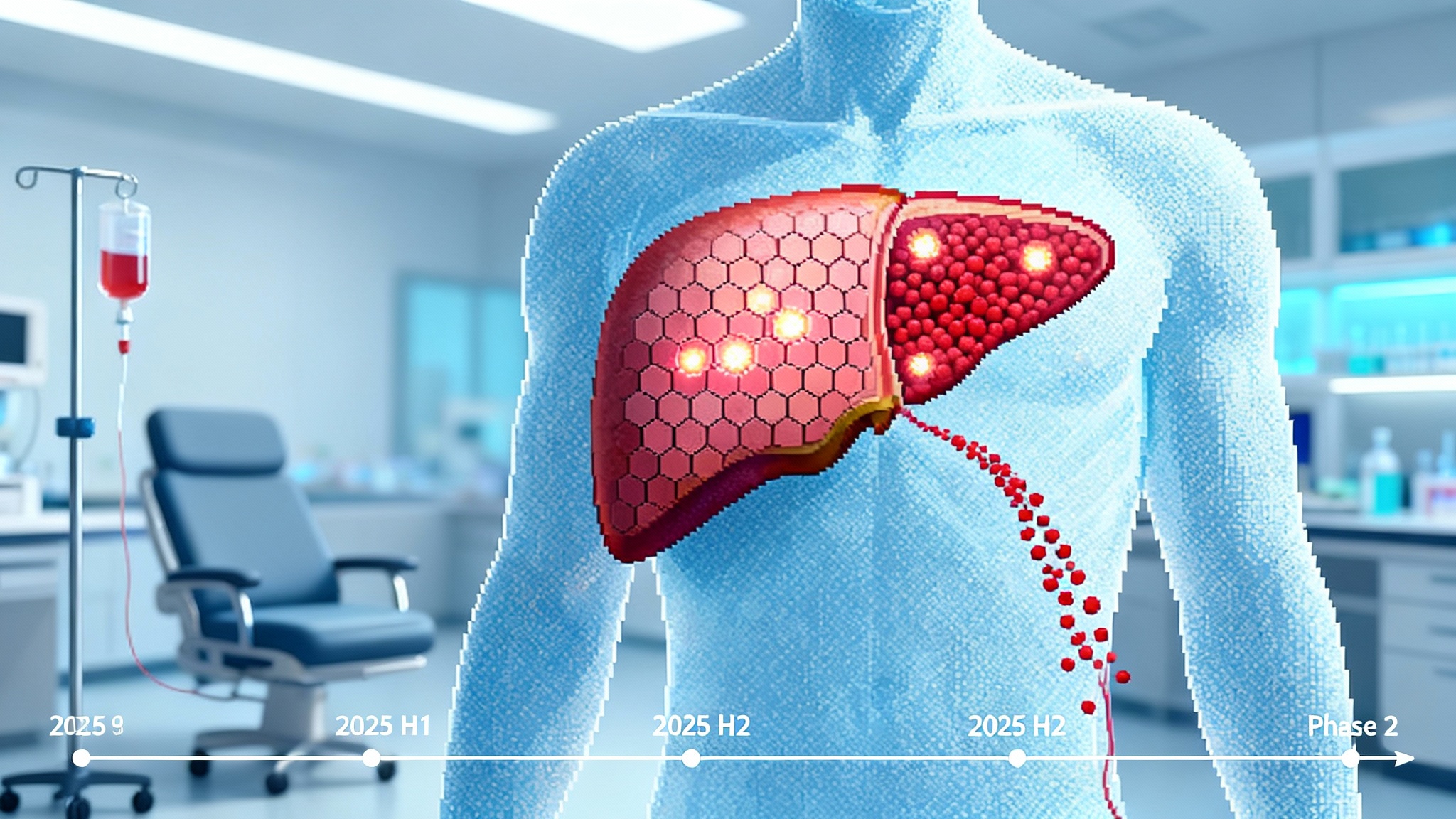Senolytics Go Clinical: UBX1325’s 2025 Eye Readouts
A first wave of peer-reviewed and conference data tests senescent cell clearance in the clinic. UBX1325’s 2025 diabetic macular edema results point to durable, disease-modifying vision gains and a credible path to Phase 3.

The first real proving ground for longevity is the eye
For a decade, senolytics have promised to do something bold. Rather than dial down symptoms, they aim to remove one root cause of age-related disease by clearing senescent cells. That promise is now meeting clinical data where medicine can see change quickly and unambiguously. In 2025 the retina became longevity’s first real proving ground.
Two readouts brought the shift into focus. The peer-reviewed journal NEJM Evidence published results from the Phase 2 BEHOLD study of UBX1325, reporting durable vision gains after a single intravitreal injection in patients with diabetic macular edema, a common complication of diabetes that blurs central vision. The paper is the first controlled, human trial readout of a senolytic in any disease with vision outcomes as the endpoint, and it shows sustained benefit through 48 weeks in a population that had already received standard anti vascular endothelial growth factor therapy. The article is indexed as NEJM Evidence BEHOLD results.
Weeks later, Unity Biotechnology presented full 36 week results from ASPIRE, a randomized Phase 2b study in diabetic macular edema that compared a single dose of UBX1325 to aflibercept, a leading anti vascular endothelial growth factor drug given every eight weeks. In a difficult to treat population, UBX1325 achieved vision gains comparable to the control arm at most time points, was non inferior at week 36, and showed stronger effects in a predefined subgroup with less severe retinal thickening at baseline. The company highlighted these data at the ARVO 2025 meeting and in its investor update; see the ASPIRE 36 week results and ARVO update.
Taken together, the BEHOLD and ASPIRE readouts do not close the case. They do something more useful. They show a repeatable clinical signal, after a single intravitreal dose, in settings where anti vascular endothelial growth factor drugs often leave patients with residual fluid and plateaued vision. That is the kind of signal that can anchor a path to approval if a sponsor designs Phase 3 studies that translate durability into fewer injections or superior outcomes in a defined subgroup. For a broader context on how trials are adapting measurements, see our aging biomarkers trial-grade playbook.
Why the eye gets senolytics first
If you wanted to pick the ideal human organ to test a new aging mechanism, you would pick the eye. Here is why.
- The eye is a closed compartment. A tiny dose can achieve high local drug levels with minimal systemic exposure. That matters for B cell lymphoma extra large targeting drugs because similar mechanisms given systemically have caused low platelets. Intravitreal dosing dramatically reduces that risk.
- The eye offers quantifiable, rapid readouts. Optical coherence tomography measures retinal thickness to the micron. Best corrected visual acuity translates to Early Treatment Diabetic Retinopathy Study letters, which regulators and clinicians accept as meaningful. Trials can run for months, not years, yet still test durability and rescue criteria.
- Rescue rules are clear. If vision worsens or fluid increases beyond a threshold, sites can rescue with standard of care anti vascular endothelial growth factor injections. That makes ocular trials ethically straightforward and analytically clean. If a new mechanism reduces the need for rescue, it shows up in the data.
The eye is also where aging mechanisms are concentrated and visible. Diabetic macular edema, age related macular degeneration, and diabetic retinopathy are all diseases where vascular cells, support cells called pericytes, and the retinal pigment epithelium accumulate stress and damage with age and metabolic disease. Senescent cells in these tissues secrete a stew of inflammatory and matrix modifying factors that keep fluid leaking and impair repair. If you can remove those chronic troublemakers, the tissue can rebalance. The BEHOLD and ASPIRE results suggest that is what UBX1325 is starting to do. These approaches complement other pathways under clinical study, such as the ones discussed in necroptosis blockers enter trials.
What UBX1325 is and how it might work
UBX1325 is a small molecule that selectively inhibits B cell lymphoma extra large, a pro survival protein that senescent cells depend on to avoid apoptosis. The logic is simple. Senescent cells have pressed the brakes on the cell cycle because of stress signals, but they have also reinforced their survival machinery. Block a protein like B cell lymphoma extra large in the location where senescent cells are abundant, and those cells become vulnerable while healthy neighbors are less affected.
In the retina, the likely senescent culprits include endothelial cells and pericytes in the capillary network, and possibly supporting glia and pigment epithelium. These cells release vascular endothelial growth factor and other inflammatory mediators that keep blood vessels leaky. Clearing them is like removing the worst tenants from a leaky apartment block. Water stops pooling in the hallways, maintenance crews can reach damaged areas, and the building’s pressure dynamics settle into a healthier pattern. In clinical terms, that means less retinal edema, fewer injections to keep fluid down, and a chance for vision to rebound as photoreceptors function in a drier environment.
Durability is the key idea. Anti vascular endothelial growth factor drugs neutralize a signal. When the drug washes out, the signal returns. A senolytic aims to remove the source of that signal. That is why a single injection that still shows an effect months later is not just convenient; it is a mechanistic fingerprint of the approach.
What the 2025 data actually show
The BEHOLD study asked a clean question. In patients with diabetic macular edema who had been receiving anti vascular endothelial growth factor therapy yet still had fluid and impaired vision, does a single dose of UBX1325 improve outcomes versus a sham procedure, with anti vascular endothelial growth factor rescue allowed when needed? The answer, over 48 weeks, was a positive trend that reached statistical significance on some analyses, including a multi letter advantage in best corrected visual acuity for UBX1325. Safety was acceptable, with no signal of intraocular inflammation or the thrombotic events that sometimes complicate ocular drug development. These are the data that appeared in NEJM Evidence in April 2025.
ASPIRE asked a harder, and in some ways more clinically relevant, question. In a head to head setting, can a single dose of UBX1325 match an every two month schedule of aflibercept in patients who were already poor responders. By week 36 the answer was nuanced. UBX1325 was non inferior to aflibercept at week 36 and achieved non inferiority at most measured time points, though not all prespecified averages across weeks 20 and 24. In a predefined subgroup of patients with central subfield thickness under 400 microns at baseline, a common scenario in the clinic, the senolytic arm performed better across many time points. Safety again looked acceptable.
Stepping back, two signals matter most for a payor or a retina specialist. First, can you reduce injection burden without sacrificing vision. Second, can you deliver superior vision in a realistic subgroup. ASPIRE suggests UBX1325 could do both if the right patients are selected and the follow up extends to the durability window.
From diabetic macular edema to age related macular degeneration and beyond
If B cell lymphoma extra large targeted senolysis is working in diabetic macular edema, where else could it apply. Three retinal opportunities stand out.
- Neovascular age related macular degeneration. This is the classic anti vascular endothelial growth factor disease with frequent injections. Even small reductions in injection frequency without loss of vision would be valuable. In patients who flatten slowly or keep recurring fluid, removing senescent endothelial and support cells could quiet the leakiness at its source.
- Diabetic retinopathy progression. Outside the macula, pericyte dropout and capillary nonperfusion create ischemic stress. A senolytic that remodels the capillary bed and quells inflammatory signaling could slow progression from non proliferative to proliferative disease. Here the endpoint would be different, likely microaneurysm dynamics or image based progression scales, but the same mechanism could help.
- Geographic atrophy and dry age related macular degeneration. This is a different beast, but senescent retinal pigment epithelium and microglia are implicated. If a B cell lymphoma extra large inhibitor can be dosed safely in eyes with poor reserve, selective clearance might reduce inflammatory cycles that accelerate atrophy. That would require careful patient selection and perhaps combination with complement inhibitors.
Outside the eye, the idea becomes more complex because systemic exposure raises platelet and other safety concerns familiar from oncology. But the eye could de risk the mechanism and provide the pharmacologic blueprint, which in turn could enable local delivery strategies in joints, skin, or even specific central nervous system compartments where the blood brain barrier can be bypassed.
The 2026 to 2027 path: what a credible approval plan looks like
The 2025 data set the stage, but they do not write the script. Here is a credible plan that a partner with an ophthalmology franchise could execute.
-
Meet regulators early. Hold an End of Phase 2 meeting in late 2025 or early 2026. Align on the pivotal endpoint framework. Two options are obvious. Non inferiority in best corrected visual acuity with a prespecified benefit on injection burden, or superiority in a clearly defined subgroup such as patients with central subfield thickness under 400 microns. Either path would require clarity on rescue rules and on how to count injections across the study period.
-
Design for durability. The central promise is fewer injections for the same or better vision. A Phase 3 program should compare a single or two dose UBX1325 regimen to fixed schedule anti vascular endothelial growth factor therapy over 48 to 52 weeks, with prespecified durability analyses at 24, 36, and 48 weeks. Imaging core labs should adjudicate fluid metrics to avoid site variability.
-
Power the right subgroup. ASPIRE’s strongest signals were in patients with thinner retinas at baseline. Prestratify on thickness and glycemic control, and ensure the study is powered to read out that subgroup without post hoc debate.
-
Run a payer friendly injection burden analysis. Count total injections including rescue, model clinic chair time saved, and convert that into a cost per quality adjusted life year framework. If the data show a real reduction in injections while holding vision constant, the economic case will write itself.
-
Map safety cleanly. Ophthalmology has been shaken by inflammation and occlusion events with some past intravitreal agents. Maintain rigorous monitoring for vasculitis, occlusive events, and intraocular inflammation, and present adjudicated data in the label enabling package. The 2025 studies reported a clean profile. Preserve it.
With this design, a partner could start Phase 3 in 2026 and deliver primary readouts in late 2027, depending on enrollment speed. A 2027 to 2028 filing becomes plausible if two adequate and well controlled studies replicate the durability advantage and the non inferiority or superiority claims.
Who stands to partner and why it matters
Unity Biotechnology signaled in May 2025 that it would explore strategic alternatives, including out licensing UBX1325. That sets up a classic build versus buy decision for companies with retinal franchises.
- Anti vascular endothelial growth factor incumbents. Regeneron and Roche Genentech have dominant positions. Both companies are defending against biosimilars and are investing in durability through high dose and sustained delivery formulations. A senolytic that reduces injection burden using a different biology would hedge their portfolios and open combination strategies.
- Challengers and platform players. Companies advancing Tie2 agonists, integrin modulators, or gene therapy approaches could see UBX1325 as a complementary option that stabilizes the vascular bed while their drugs tune the signaling environment.
- Asian ophthalmology leaders. Firms with strong distribution in diabetes heavy markets could see a strategic fit if pricing for a low frequency intravitreal makes sense in national reimbursement schemes.
A partnership is not only about money. It is about trial infrastructure, imaging core relationships, and commercial footprints in retina clinics. The right partner brings the sites, the statisticians, and the payer analytics needed to make an injection saving claim stick.
What could still go wrong
Three risks deserve clear eyes.
- Signal dilution in broader populations. If Phase 3 enrolls many patients with very thick retinas or advanced ischemia, the senolytic benefit could be masked by irreversible damage. Prestratification will matter.
- Safety surprises with repeat dosing. A single dose looks clean. If Phase 3 includes a second dose to extend durability, the safety database must be large enough to quantify low frequency events.
- Competitive dynamics. High dose anti vascular endothelial growth factor regimens and port delivery systems are improving durability. UBX1325 will need to show either fewer injections with equal vision, or better vision at similar injection counts, in a pre specified population. Anything less will limit uptake.
What clinicians can do now
- Identify the target phenotype. In practice, that likely means diabetic macular edema patients who respond to anti vascular endothelial growth factor drugs but plateau with persistent fluid and visual deficits, and whose central subfield thickness is not extreme. These are the patients most likely to benefit if UBX1325 secures approval.
- Tighten imaging protocols. If your clinic standardizes optical coherence tomography metrics and documents rescue criteria rigorously, you will be ready to translate a durability claim into scheduling and staffing changes.
- Track injection burden. Start measuring chair time and technician utilization per injection in your clinic today. If a senolytic reduces injections even modestly, the operational benefit could be large.
The bigger picture for aging medicine
The clinical trick here is not only prolonging life but restoring function with fewer touchpoints. The eye shows how that might look in practice. Small molecules delivered locally, targeted clearance of damage prone cell populations, quantifiable gains in organ level performance, and a path to reimbursement based on fewer interventions. This sits alongside next generation strategies like epigenome editing enters humans.
If UBX1325 reaches Phase 3 with a strong partner and a durability focused design, it will do more than add another retina drug. It will give aging biology a public, day to day clinical footprint in the United States and beyond. That will encourage investors and regulators to consider senescent cell clearance as a modifiable, approvable mechanism in other tissues where local delivery is feasible.
The bottom line
In 2025, senolytics left the theory slide and entered the retina clinic. A single dose of a B cell lymphoma extra large targeted drug produced durable vision improvements in a controlled trial and matched an every two month anti vascular endothelial growth factor regimen in a head to head study at key time points. The data are not perfect, but they are coherent, mechanistically aligned, and clinically relevant. If a partner moves quickly, 2026 to 2027 can convert that coherence into regulatory momentum. The eye is showing longevity the way forward, one clear letter at a time.





